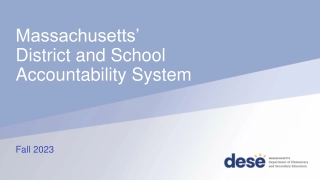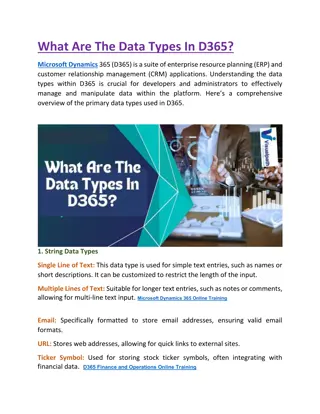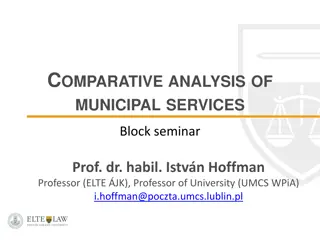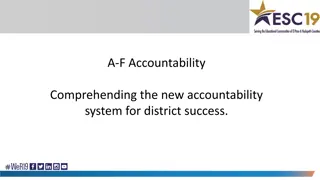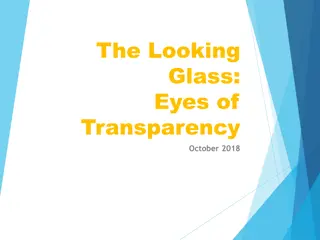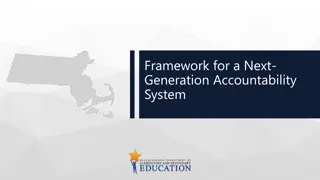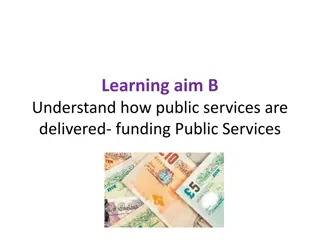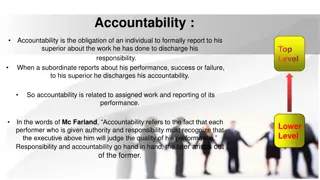Dynamics of Accountability in Public Services
Governance reforms have reshaped accountability dynamics in the public sector. This comprehensive study delves into the changing nature of accountability relationships between managers, politicians, and citizens, tackling the complexities arising from multiple accountability demands and shifts in patterns.
Download Presentation

Please find below an Image/Link to download the presentation.
The content on the website is provided AS IS for your information and personal use only. It may not be sold, licensed, or shared on other websites without obtaining consent from the author.If you encounter any issues during the download, it is possible that the publisher has removed the file from their server.
You are allowed to download the files provided on this website for personal or commercial use, subject to the condition that they are used lawfully. All files are the property of their respective owners.
The content on the website is provided AS IS for your information and personal use only. It may not be sold, licensed, or shared on other websites without obtaining consent from the author.
E N D
Presentation Transcript
Governance reforms and the dynamics of accountability in public services Katarzyna Lakoma, Dr Peter Eckersley, Prof Peter Murphy Nottingham Trent University UKAPA Conference, Birmingham 12-13 September 2024
Accountability of public services In the public sector, accountability concerns the relationships between public managers, politicians, and citizens managers, politicians, and citizens (Mulgan 2000). Public services have been subjected to various governance reforms that invariably promise improved accountability improved accountability (Dubnick and Yang 2011). Governance reforms often resulted in multiple accountability demands and shifts in in multiple accountability demands and shifts in the pattern of accountabilities the pattern of accountabilities (Byrkjeflot et al. 2014, Grubnic and Cooper 2019, Hansen et al. 2019, Lakoma 2024). The nature and form of accountability in the public sector has been changing and has been portrayed as extremely complex extremely complex (Bovens et al. 2014, Murphy et al. 2019), making public services tangled in a web of different, and often conflicting forms of accountability (Piatak et al. 2018, Aleksovska and Schillemans 2022, Lee 2022). the relationships between public
Theoretical perspectives on accountability Romzek and Dubnick identified four types of accountability: four types of accountability: bureaucratic, political, legal, and bureaucratic, political, legal, and professional professional (1987) based on two dimensions the source of control and the degree of control. Figure 1: Figure 1: Accountability typology identified by Romzek and Dubnick (1987) and later refined by Romzek (2000)
Accountability typology Type of Type of accountability accountability Authors Authors Relationship Relationship Characteristics Characteristics Mechanisms Mechanisms Bureaucratic Bureaucratic (Administrative, (Administrative, Managerial, Managerial, Hierarchical) Hierarchical) Romzek and Dubnick (1987), O Laughlin (1990), Sinclair (1995), Page (2006), Bovens (2007), Willems and Van Dooren (2011), Lindberg (2013) Superior subordinate Hierarchic, obedience to organisational directives, efficiency Supervision, rules, regulations Legal (Judicial) Legal (Judicial) Romzek and Dubnick (1987), O Laughlin (1990), Page (2006), Bovens (2007), Willems and Van Dooren (2011), Lindberg (2013) Policy maker - implementer Rule of law Courts, formal judicial trials, and procedures Professional Professional Romzek and Dubnick (1987), O Laughlin (1990), Sinclair (1995), Page (2006), Bovens (2007), Lindberg (2013) Layperson expert Expertise Expert scrutiny, peer review, standards, values Political Political Romzek and Dubnick (1987), O Laughlin (1990), Sinclair (1995), Page (2006), Bovens (2007), Willems and Van Dooren (2011), Lindberg (2013) Constituent elected representative External, democratic Voice, elections, budget control Table 1:Classifications of accountability (Source: Authors)
An underlying rationale for many New Public Management and post-New Public Management reforms has been a desire to improve public services accountability accountability, even though this has not necessarily been achieved (Pollitt 2000, Heinrich 2002). improve public services Governance reforms The experience of public management reforms suggests that governance reforms seem to be aimed at certain forms of accountability certain forms of accountability (Romzek 2000). They often redefine the forms of accountability redefine the forms of accountability inherent in existing governance structures and create new accountability dynamics. new accountability dynamics. create
Research gap It remains unclear why and how governments why and how governments, who ultimately direct and control public services, might seek to improve the accountability of public services through governance , might seek to improve the accountability of public services through governance reforms reforms in the first place, and how these reforms change existing accountability how these reforms change existing accountability dynamics dynamics within a public service. Our literature review reveals that governments introduce reforms to try to change the governments introduce reforms to try to change the focus of accountability in the public sector focus of accountability in the public sector following perceived accountability deficits in an attempt to depoliticise an issue and avoid the blame for potentially unpopular decisions (Burnham 2001, Flinders and Buller 2006).
Towards a conceptualisation Figure 2: Accountability typology identified by Romzek and Dubnick (1987) and later refined by Romzek (2000) Figure 3: Figure 3: Analytical framework Source: Authors and adapted from Romzek and Dubnick (1987), Romzek (2000) Introducing dynamism Introducing dynamism
Governance reforms results in accountability shift Initial focus of accountability (dimensions) Expected focus of accountability (dimensions) Government concern a. Insufficient control of an agency a. Insufficient control of an agency From: Bureaucratic accountability To: Legal accountability Internal control, low autonomy External control, low autonomy From: Professional accountability To: Political accountability Internal control, high autonomy External control, high autonomy b. Excessive control of an agency b. Excessive control of an agency From: Legal accountability To: Bureaucratic accountability External control, low autonomy Internal control, low autonomy From: Political accountability To: Professional accountability External control, high autonomy Internal control, high autonomy c. Insufficient autonomy of an agency c. Insufficient autonomy of an agency From: Bureaucratic accountability To: Professional accountability Internal control, low autonomy Internal control, high autonomy From: Legal accountability To Political accountability External control, low autonomy External control, high autonomy d. Excessive autonomy of an agency d. Excessive autonomy of an agency From: Professional accountability To: Bureaucratic accountability Internal control, high autonomy Internal control, low autonomy From: Political accountability To: Legal accountability External control, high autonomy External control, low autonomy
Governance reforms results in accountability shift Initial focus of accountability (dimensions) Expected focus of accountability (dimensions) Government concern a. Insufficient control of an agency a. Insufficient control of an agency From: Bureaucratic accountability To: Legal accountability Internal control, low autonomy External control, low autonomy From: Professional accountability To: Political accountability Internal control, high autonomy External control, high autonomy
Governance reforms results in accountability shift Initial focus of accountability (dimensions) Expected focus of accountability (dimensions) Government concern b. Excessive control of an agency b. Excessive control of an agency From: Legal accountability To: Bureaucratic accountability External control, low autonomy Internal control, low autonomy From: Political accountability To: Professional accountability External control, high autonomy Internal control, high autonomy
Governance reforms results in accountability shift Initial focus of accountability (dimensions) Expected focus of accountability (dimensions) Government concern c. Insufficient autonomy of an agency c. Insufficient autonomy of an agency From: Bureaucratic accountability To: Professional accountability Internal control, low autonomy Internal control, high autonomy From: Legal accountability To Political accountability External control, low autonomy External control, high autonomy
Governance reforms results in accountability shift Initial focus of accountability (dimensions) Expected focus of accountability (dimensions) Government concern d. Excessive autonomy of an agency d. Excessive autonomy of an agency From: Professional accountability To: Bureaucratic accountability Internal control, high autonomy Internal control, low autonomy From: Political accountability To: Legal accountability External control, high autonomy External control, low autonomy
Discussion and conclusions Our analysis complements and extends the studies of Romzek and Dubnick (1987) and Romzek (2000) because it illustrates real real- -life accountability dynamics from governance reforms. life accountability dynamics that result We explain why services through governance reforms, and how accountability dynamics within a public service. why governments might seek to improve the accountability of public how these reforms change existing Governments either extend decrease the service s autonomy decrease the service s autonomy, generally in response to perceived accountability deficits following sudden shocks (e.g. failures, scandals, emergencies, crises). extend or reduce reduce control over public services control over public services, and/or increase increase or Governments avoid blame other actors other actors (Flinders and Buller 2006). . avoid blame and introduce reforms that shift the accountability focus to shift the accountability focus to As such, they change the balance of different types of accountabilities change the balance of different types of accountabilities in public services. .
Thank you Questions? Comments? katarzyna.lakoma@ntu.ac.uk


